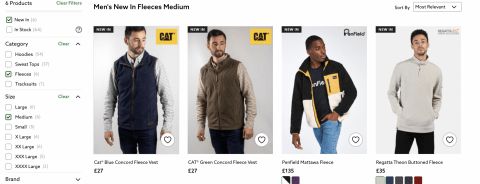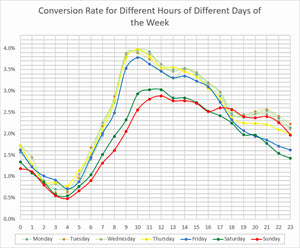Interactive content requires active engagement from the user. It removes the passive element and ensures the user becomes an integral part of the dynamic, providing a two-way experience. It’s easy to see why content like this is so popular.
And interactive content is a way to cut through the tidal wave of social content. In relation to the rise of social media, Data collated during 2019 presented a handful of incredible statistics. Approximately, there were:
- 67,305,600 Instagram posts a day
- 682 million tweets a day
- More than four hours worth of YouTube content uploaded each day
- Two billion active users on Facebook
With approximately more than four billion internet users, there’s a lot of content being created and new techniques being explored. It comes back to cutting through the noise and finding innovative new ways to stand out from the legions of online chaff has become imperative for content marketers across all industries in the digital landscape.
However, adopting it without fully weighing up the benefits and risks can be a costly mistake.
How can this be achieved? Believe it or not, you don’t need to go above and beyond to create this type of content.
It can be as simple as producing a user poll or a more sophisticated bespoke tool that crunches through data to compute a result, just as mortgage or insurance calculators do:

Such interactive content is becoming increasingly popular. More statistics show that in the B2B industry:
- 88% of marketers said that interactive content is effective in differentiating their brand from their competitors
- 81% of marketers agree that interactive content is much more effective at grabbing people’s attention than static content
- 79% of marketers said interactive content can be reused a lot, leading to repeat readers
Marketers are not just competing against other businesses anymore. News outlets and influencers are also vying to get noticed, and offering something a little different may be just what it takes to grab a user’s attention.
First question… Is it worth it?
Judging by the statistics outlined above? Yes, absolutely. Content marketers that are already onboard the interactive content train would agree, too. Here’s just a few reasons why:
- Cutting through the noise – There’s A LOT of content. Four years ago, Statista predicted there would be over 100 million bloggers worldwide and during March 2019, statistics showed that approximately 4.4 million blogs were published each day. Standing out from the crowd is truly more important than ever before.
- The age of the mobile – Everyone is connected to everything in the palm of their hand and each one of those people is looking for a personalised experience based on their geography and interests.
- Even human nature comes into it – Most people are primed to want to compete, connect, and learn. We instinctively want to be the best at something, be part of a group, earn loyalty and points, or learn something new and exciting – all reasons why gamification is so popular in the industry right now.
How Can Interactive Content Benefit You?
Why is interactive content so great? Here are just a few reasons why:
- Personalisation – By asking customers a few simple questions about themselves, you can present the user with precisely the information that caters for their specific needs.
- Insights – Interactive content could reveal useful information about your customers, such as their preferences, interests and wants.
- Engagement – There’s something about a great game or quiz that’s irresistible, isn’t there? If your content entertains readers, they’re more likely to spend time sticking around engaging with it. Ion Interactive reported that interactive content is 81% more likely to grab attention compared to static and is far more likely to be shared on social media, which will further boost your rankings in search engines.
- Data visualisation – If you hold a lot of data, interactive tools can help simplify the information and present it in a visual way that’s easy to digest. Ever wondered how many languages there are in the world and where they are spoken? DensityDesign did a great job collating all of that data that any non-linguist would be able to consume.
- Problem solving – Producing content that users find useful is key to gaining traction in content marketing. For example, if you sell a huge array of products, your customers may be overwhelmed by the choice on offer.
I’m sure you’re familiar with filters? Below, you can see how on the Next site you can easily cut from more than 1,000 products down to the 6 that you are more likely to be looking for:

What Types Of Interactive Content Are Out There?
There are a huge number of ways to incorporate interactivity into your content. Here are just a few popular examples:
- Calculators – These are great for problem-solving and can save customers’ time too.
- Polls and surveys – You can use these to open up a discussion with your customers and make them feel involved in your brand. You can also gain valuable insights into what matters to them, allowing businesses to better tailor their approaches.
- Assessments – Diagnostic or troubleshooting tools are exactly the kind of useful content people love.
- Heat maps – Often used to visualise results in elections, these can equally be used to illustrate regional differences in other scenarios.
- Quizzes and competitions – The appeal of testing yourself makes quizzes a popular form of content and they can be used for fun and more serious topics. Offering out prizes as part of a quiz or competition is a proven winner in boosting engagement rates for content of this nature.
- VR – Virtual reality has come a long way in a short amount of time and is predicted to boom and shape our future in the coming years. This technology is used in a number of sectors; including gaming, real estate, architecture, retail, and education. Is there anything more exciting right now than being able to fully immerse yourself in a computer-generated environment, allowing you to see something you, otherwise, wouldn’t be able to see?

And that’s just for starters.
Videos, gamification, filters, infographics, eBooks, brochures, whitepapers, timelines, emails and lookbooks are others options that many businesses turn to when it comes to creating interactive content.
What Are The Potential Drawbacks?
Interactive content often sounds exciting and promising, which makes it easy to pursue before properly considering if it’s the best option.
One thing to stress is that simply adding an element of creativity doesn’t always guarantee results in itself. Asking a few simple questions beforehand can help you decide if you’re making the best choice:
- Are you simply putting an unnecessary barrier in the way of the customer getting what they need?
You need to be wary of over-complicating something that could be done a lot more simply because you could turn off your audience. Consider this; in the digital landscape, it is estimated that you will hold a customer’s attention span for eight seconds once they are on the page.
Putting unnecessary roadblocks in place is likely to lose you key conversions. If you’re asking for personal information, be sure it’s clearly warranted, so it doesn’t make people wary of engaging with your content.
- What’s in it for the audience?
Like with any piece of content, you shouldn’t lose sight of what your audience needs. Aim to inform or entertain them. Ask yourself another question. Does the content you are creating serve a purpose?
- Do you have clear goals that producing the content will help you achieve?
Don’t be vague about what you want to achieve. Make sure you have a clear goal in mind and think about how you’ll measure your success too. For instance, if your tool recommends products, you can track the sales generated. Or, if you’d like to capture leads, you can track how many email addresses you get.
Things To Consider…
If you’re creating your own bespoke tool from scratch, you also need to consider the potential downsides of investing in interactivity:
- Lack of staff and cost – Ion Interactive’s 2017 report, The Symphony of Interactive Content Marketing, stated that these two issues were the top reasons why marketers did not pursue the use of interactive content. Often sophisticated or bespoke interactive tools often require expensive technical expertise to create and lack of that and budget can be intimidating.
- Time – Creating a tool that crunches through masses of data, or needs a complex algorithm, can be time-consuming, especially if you need to test that all the possible outcomes it could produce are correct.
- Load times – Complex tools can slow down your website if they have a lot going on in the background. You need to have a clear view of how your tool may impact the load time of your website. You’ve heard of the three-second rule? Google’s statistics showed in 2019 that 57% of visitors leave a site if it takes too long to load. Don’t let your shiny new interactive content be the cause of that.
- Browser and device compatibility – Unlike straight forward text and image-based articles, not every browser or device will necessarily be able to cope with certain elements of interactivity. At the very least, make sure your tool works on the browsers and devices your audience uses the most. For example, tools with fiddly buttons to click will be a no-no on mobile phones.
- SEO – Embedding content using iframes (where there appears to be a website within a website) can be a convenient way of incorporating interactive content onto a page. But you need to make sure your iframed content doesn’t contain all your keywords because they won’t be picked up by Google.
If you don’t need to create something completely bespoke, there are a number of free or relatively cheap tools you can use to create your content, such as SnapApp, Qzzr, Survey Monkey, MapMe, Apester, Typeforms, Calculoid, Google Maps’ JavaScript API and ThingLink.
Conclusion
The influence of interactive content has come a long way in a short amount of time and the question you need to be asking yourself is whether you can afford not to be doing it?
Even the simplest approaches, like polls, quizzes, surveys and calculators are proven to make a huge difference in engagement, allowing businesses to get ahead of the competition and cut through the digital noise.
Have you just learned something new?
Then join the 80,000 people who read our expert articles every month.








